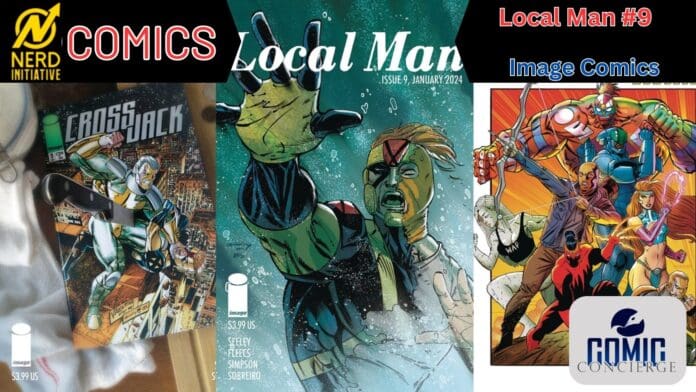Share this

Created / Written / Art: Tony Fleecs & Tim Seeley
Colors: Brad Simpson, Felipe Sobreiro
Publisher: Image Comics
The superhero genre has provided storytellers with plenty of material for nearly ninety years. It has been constructed, deconstructed, and everything in between. Despite the plethora of material people still find new ways to approach the genre.
One of the most recent examples is Tim Seeley and Tony Fleecs Local Man series. Unlike a lot of modern superhero tales, this is not attempting to deconstruct the genre rather it operates as a validation of it. One that encompasses all the different ways to approach superheroes and how those diverse styles can work in tandem with one another.
Each issue of this series has been two stories in one. The first takes place during modern times as Jack, formerly the superhero Crossjack, has been forced to return to his hometown and stop being a superhero.
Despite the legal ramifications he still cannot help himself from playing that role. There is also a backup story that takes place during the glory days of Crossjack and is done in a very 90s Image style with art by Tim Seeley.
We are nearing the end of this current arc as Jack has learned the truth regarding what has been happening in his hometown. Corruption has run deep, but considering the person behind it is one of the few people he cares about can he put a stop to it? Due to his power, he never misses, but what if he is unable to take the shot? Adding more challenges to the mix, tragedy strikes Jack and his family just as chaos begins to erupt.

During this arc, the meta elements had been at the forefront. After Jack unknowingly took some rather strong drugs he became self-aware he was in a comic to the point he began to interact with the page and dialog balloons.
The running gag of him running into the end of the panel was a great touch. As the story has become more serious those comedic elements have subsided. Being a fan of their execution I was sad to not see them. Considering the tonal shift this issue takes it was the right choice however.
As mentioned this series has been looking at the idea of superheroes and what they can be. One of the key tropes of superheroes is the impact of tragedy. Spider-Man lost Uncle Ben, Batman lost his parents, and Superman lost his entire planet…so what has Jack lost?
His tragedy was not as immediate and a bit more complicated. The first takes place during his time as a superhero as he was force to make a difficult choice. Considering it is a reflection of 90’s comics it speaks to the messy morality those heroes often played in.
With this issue, the tragedy is a bit more traditional. The bad person does a bad thing causing our hero to feel pain. Despite being different flavors of storytelling they yield intriguing story elements. Just another example of showing how different approaches have their value.
The key to making this all cohesive is the art of both Seeley and Tony Fleecs. As mentioned Seeley does the backup story and even as someone who was never a huge fan of that style, I can appreciate it within the context of this story.
Every page is something exciting and in this issue, they even played with the coloring choices a bit. It starts as black and white but due to the events within the story, it changes to splashes of vibrant colors.

Fleecs draws in a much more modern style. His character models are far more true to life and the costumes are toned down. If you were to look at this comic from afar you may not even think it was a superhero story.
Within that juxtaposition, magic happens. It is like being a kid and seeing your teacher outside of school in a public place. You see an entirely different side of a person you thought you knew.
Fleecs greatest skill may be the way he renders body language. Jack spends a great deal of these issues in a ski mask, yet great drama and comedy come from the way he stands in a scene.
A slight head turn after hearing something rather shocking clue into what he is thinking. His wide eyes peak through the small slits making you understand the realization that just occurred. Very subtle but effective storytelling, which again compares nicely to the more bombastic style that follows.
The family and human drama have been at the forefront of this narrative thus far, and now that this delves into the more genre aspects that work is paying off.
The stakes here are not world-ending–they are family-ending and that hurts even more. I still do not know if I understand the mindset behind some rather drastic character choices, but with one more issue to go, I hope that can be cleared up.
Final Score: 4/5


